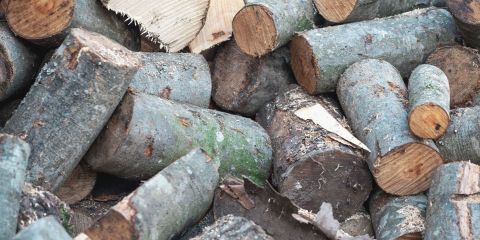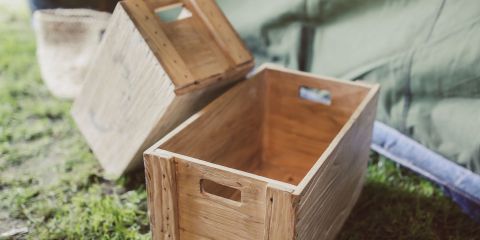How many pieces of furniture do you have in your bedroom? Probably at least a mattress, a bed frame, a dresser or two, a couple of night stands, maybe a headboard, a desk, vanity, an upholstered chair or a couch. And you probably have more than one bedroom to furnish. Add it up across a couple of rooms and you’re already nearing 20 pieces of furniture.
Between the materials they’re made with, the processes involved in manufacturing them and the resources required to distribute them, bedroom furniture doesn’t just add up in numbers -- it adds up in environmental impact, too.
And considering that humans are cutting down around 15 billion trees a year -- trees that are a vital part of healthy ecosystems, trees that absorb carbon to combat global warming and trees that form the basis for much of life -- it’s important to play a role in ensuring that when we do need to use them, it’s in a responsible way.

So why not consider sustainable furniture options? Sustainable furniture is any piece of furniture made in an environmentally sustainable fashion. That covers the entire lifecycle -- being made either from sustainable materials, through a sustainable manufacturing process, distributed in an environmentally friendly way, or designed with reuse and repair in mind.
Sustainable materials: What it’s made of
Any number - or combination - of factors make a piece of furniture “sustainable.” When you’re looking for your next piece, keep these features in mind:
- Made of recycled or salvaged content (wood, plastics, metals)
- Made of renewable or organic materials
- Able to be recycled (along with the packaging)
- Able to be modified, reconfigured, repurposed
- Durable and long-lasting
- Contains zero or low levels of chemicals
- Sustainable supply chain and manufacturing process
- Parts are able to be replaced or repaired
- Compatible with green and mild cleaning chemical
- Easy replacement and serviceability of key parts

The materials from which sustainable furniture is made is the first consideration to make when perusing for options. They can be any of the following:
- Lumber: Look for lumber that’s been produced in an ecologically responsible manner. Knowing deforestation is a major global concern, look for furniture that has been produced by lumber companies that cut trees in a thoughtful and intentional way. A good way to tell is to look for pieces certified by the Forest Stewardship Council, an environmental organization that sets the standard for responsible and certifies both companies operating in accordance with these standards and retailers selling the resulting wood products.
- Bamboo: Bamboo is quickly gaining ground as a hyper-sustainable lumber trend, duie to its ability to grow quickly and ion diverse climates. It regrows quickly after being harvested.
- Non-toxic/water-based finishes: Most furniture has a finish that protects it from scratching and damage, and may give it an even, lustrous look. However even if your furniture is made from the most sustainable lumber and bamboo, it may be finished with toxic chemicals, like solvent-based lacquer, that contribute to the pollution in your home by emitting volatile organic compounds (VOCs), like formaldehyde. It is possible to buy furniture without these toxic chemicals. Water-based lacquers are a green alternative to finishing wood furniture. If you’re unsure if a varnish is solvent or water-based, check the label. Most varnishes will note if they have a low VOC, which is what you want.
- Recycled and reclaimed materials: This could be wood, iron, glass, you name it. Some eco-friendly furniture companies will recycle material to make furniture -- some even use factory wood scraps or flawed wood pieces. Wood is a popular material to reclaim, as it’s durable.
Sustainable manufacturing: how it’s made
The entire process of production in general can become incredibly resource-intensive, especially when it comes to mass production.

On a large scale, heavy machinery is required to create materials and assemble heavy parts. That machinery needs to be cooled with lots of water, and the energy required releases heavy loads of carbon dioxide emissions.
Toxic chemical byproducts can leach into local soil and waterways, harming the health of the local environment and communities depending on those resources.
When possible, look for furniture that is made in small batches and by hand. If that’s not an attainable option, keep an eye out for sustainable supply chain labels, which we’ll discuss later on.
Sustainable distribution: how it gets to you
Another component of sustainable furniture is the distribution -- how does the product get from the factory in which it was manufactured, to either the store in which you purchase it or directly to your doorstep? If the furniture was manufactured far from its eventual destination, the environmental impact of transporting it from beginning to end has a significantly higher environmental impact.

Think about the harmful carbon dioxide emissions required to ship a dresser made in China all the way to the end consumer in Australia. You’ve got freight trucks, large cargo planes, maybe gas-guzzling cargo ships. Now think about the emissions involved in transporting a locally made piece of furniture from a nearby town or city.
Purchasing furniture from local sources doesn’t just help reduce emissions, it also helps support local businesses.
When you’re able, try to avoid shopping online for direct delivery - or, if you have to, try to avoid the rush shipping that only escalates the release of these emissions - and instead opt to support your neighborhood furniture dealer.
How can I find sustainable furniture?
Here are some questions to ask when you’re trying to make a decision. If the answers are “yes,” chances are you’re buying a sustainable product.
- Does the item contain chemicals like contain formaldehyde, flame retardants or stain resistant sprays?
- Is the fabric used certified under the Global Organic Textile Standard program?
- Is the wood used certified as sustainably harvested by the Forest Stewardship Council (FSC)?
- Does the item contain parts or pieces that come from bamboo, reclaimed wood or recycled metal or plastic?
- Is it easy to disassemble into reusable or recyclable parts if it needs to be replaced down the line?
And how can I tell if it’s really sustainable?
As mentioned earlier, some sustainability standards are available to verify the environmentally friendly design, sourcing, production and/or distribution of your furniture.

You’ll notice some standards on this list are focused more on the materials themselves, while others focus on ensuring sustainable production or distribution. The entire product lifecycle is good to consider as you make your decision. Here are some certifications and standards to look out for:
For sustainable product material...
- Forest Stewardship Council® (FSC) standards : The FSC is the gold standard for verifying “green” furniture makers and related retailers, suppliers and designers. Formed in 2006, the organization has become a network of around 400 sustainable participants in the furniture making supply chain. You can browse their membership list when considering your next furniture purchase. However keep in mind, just because a furniture maker is listed with SFC doesn't mean it completely eschews chemicals or unsustainable wood, but just that’s moving in that direction.
- Global Organic Textile Standard (GOTS) program: GOTS mandates that at least 70 percent of fibers in fabric are derived from organic sources and do not contain chemical dyes or other additives.
- Certipur : This is a good certification to look out for when you’re purchasing bedding for upholstered furniture. It verifies advance the safety, health and environmental (SHE) performance of flexible polyurethane foams used in bedding and upholstered furniture.
- Rediscovered Wood Certification : The Rainforest Alliance helps determine if a piece of furniture actually uses reclaimed wood, providing the Rediscovered Wood Certification to qualifying furniture pieces.
- Greenguard , Oeko-Tex and MAS Certified Green : All certifications verify low toxicity rates in furniture, delineating low VOC emitting products.
- ÖkoControl : This label is given tourniture, bedding or mattresses made of natural, sustainable materials after strict tests made by independent and accredited test laboratories. It also guarantees the manufacturing process resulted in a low output of dangerous emissions.
For sustainable product manufacturing…
- CarbonCare : This label recognized the efforts of organizations tackling climate change by measuring, reducing and offsetting their carbon footprint. That means they’re working toward a more sustainable manufacturing process. CarbonCare is less about the material and more about the process.
- Carbon Neutral Product Certification : This program requires companies undergo a comprehensive carbon audit to assess emissions used in the production of raw materials, as well as in fuel, electricity and water for the production and distribution of their product. Again, this certification accounts mor for production and distribution than raw materials.
- Good Environmental Choice Australia (GECA) : This nonprofit, multisector, eco labeling program attests to a product’s sustainable supply chain
For sustainable product design...
- Cradle to Cradle (C2C) Certified : This is a third-party sustainability label that verifies the furniture can be dismantled, its individual parts can be recycled at a facility or reused in other furniture. Easy furniture disassembly also allows for quick and easy repairs, which extend the life of the piece.
For holistic sustainability...
- NSF/ANSI 336 : Sustainability Assessment for Commercial Furnishings Fabric: This NSF ecolabel addresses all impacts of a furniture product, including environmental, economic and social. THe standard applies to fabric products.
- SFC Member Seal : The Sustainable Furnishings Council (SFC) Member Seal is a label recognizing companies involved in the furnishings industry that have made a public commitment to sustainability, transparency and improvement.
The bottom line?
Putting in a little bit of research from the outset helps you play your part in responsibly stewarding our planet and its limited resources. Supporting sustainable brands with your dollars is the best way to ensure sustainable practices continue - and continue to improve.

